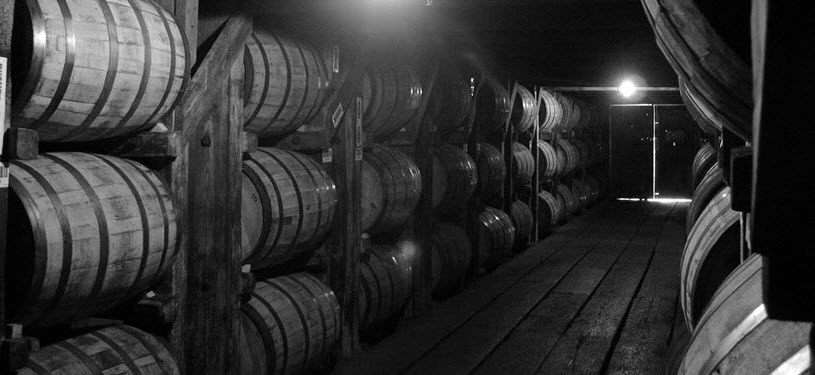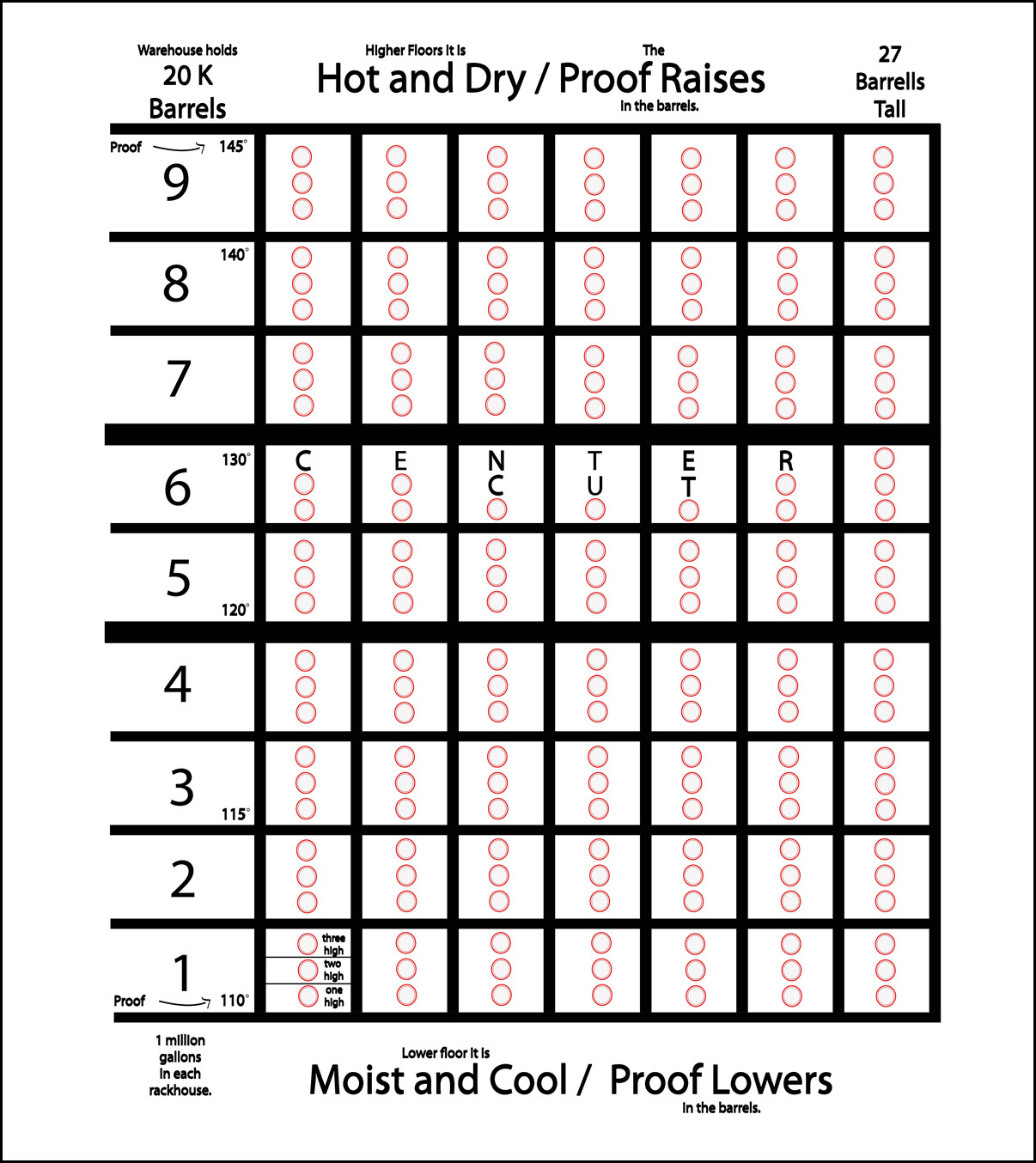
Most large distilleries have several different types of warehouses. Some are wood, or brick, or tin or concrete block. Some are tall while some are short.
Moving Barrels
To move barrels around, some use elevators, some use escalators, and some use forklifts. An elevator house is the most traditional, and the most labor intensive. The barrels are stored and pulled from barrels set in a rick by a crew of up to five people and moved by elevator. It takes a couple less folks to do the same in an escalator house, and only one for a palletized house.
A 20,000 Barrel Rackhouse Layout – About 1 Million Gallons of Bourbon!
The diagram here shows just what’s going on in a traditional nine story rackhouse which holds 20,000 barrels (roughly 1 million gallons of bourbon). Most of these barrels are stored at an entry level proof of 125.
Stay Informed: Sign up here for our Distillery Trail free email newsletter and be the first to get all the latest news, trends, job listings and events in your inbox.
Click here to see the full size distillery rackhouse illustration.
The Angel’s Share – Evaporation Effects Proof
- Water molecules are small
- Alcohol molecules are much larger
Since a water molecule is very small, it is easier for it to escape through the barrel than the much larger alcohol molecule. The atmosphere at the top of a rackhouse is very hot and dry, allowing the water molecules to escape much faster than the alcohol molecules thus driving the proof up ▲ in those barrels and concentrating the flavors inside the barrel.
Barrels at the Top of a Rackhouse Age at an Accelerated Pace – Proof Raises
The barrels at the top of the rackhouse (floors 7-9) are located where it is hot and dry. Water molecules in those barrels escape easier driving the proof up ▲ to around 145 at the very top.
Barrels at the Bottom of a Rackhouse Age at a Slower Pace – Proof Lowers
The atmosphere at the bottom of the rackhouse (floors 1 – 4) is moist and cool. Since a water molecule is very small, water can penetrate the barrel from the surrounding moisture and that drives the proof down ▼ to around 110 in those barrels.
Barrels at the Middle of the Rackhouse – The Center Cut
Barrels at the middle, what the late Booker Noe of Jim Beam called the “Center Cut” stay more constant, varying just a little bit in those floors where you don’t have the extreme fluctuations.
1 High, 2 High, 3 High
You can see in the diagram that there are three barrels on each floor – we call those the one high, two high, and three high. With 9 floors in the rackhouse that makes 27 barrels tall. Take a close look at how the proofs vary from floor to floor. Also notice that barrels on the inside of the house age differently than on the outside as well, since the barrels on the outside get more heat closer to the walls. So where you put the barrels effects those barrels in different ways.
Single Barrel vs. Small Batch
Some distilleries use the location of the bourbon in the rackhouse as their small batch.
- At Jim Beam, Baker’s Bourbon goes in mid high and high storage. That’s why it has a big bold flavor and a totally different mouth feel.
- Booker’s goes in to the Center Cut.
- Basil Hayden’s and Knob Creek is more mid low to mid high not touching the bottom couple floors or the top couple floors.
Many barrels are mingled together for a small batch so that those have a consistent taste from bottle to bottle and batch to batch over the years. A single barrel (Knob Creek Single Barrel Reserve) is from only one barrel at a time. So you can see that if we bottle all the bourbon from the two high on the 3rd floor – and the next barrel all the bottles come from the one high on the 6th floor – those will taste different!
At Buffalo Trace, they have wood and tin rackhouses, brick, and concrete block rackhouses. Bourbon ages differently in each type of house, so they put certain bourbons in certain types of houses, and that’s what makes up the differences in their small batch and single barrels.
Confused of what the differences between small batch and single barrel? I’ll make it simple.
A better way to picture it is to say I sent you three barrels of bourbon (which you’d love me to do) and I asked you to store one barrel in your basement, the second on your main floor, and the third one in your attic. If your air conditioning goes out in the dog days of August where are you likely to go hang out until it’s fixed? The basement right, where it’s moist and cool even on the hottest day. That same day, it might be 140 degrees on the top floor. Now, let’s say you didn’t turn on your A/C or your furnace for 12 full years and had those three barrels of Elijah Craig aging there the whole time. Do you think that over those 12 years that when you tasted bourbon from those barrels that they might taste a little different from each other? Of course they would – and that’s Single Barrel.
If we mingled those same thee barrels together and did that each time can you see where those will level out and taste similar to each other from bottle to bottle – and that’s Small Batch.
That’s the difference between Single Barrel and Small Batch bourbons. You now know a LOT more about aging, rackhouses, and bourbon than you did five minutes ago. Now, it’s time to go do some taste testing of your own!
Want to learn more about Barrel Maturation? Check out this three part series.
Part 1: Understanding Oak Barrel Maturation – Know Your Casks
Part 2: Understanding Oak Barrel Maturation – Maturity is Not Age
Part 3: Understanding Oak Barrel Maturation – Location, Location, Location





